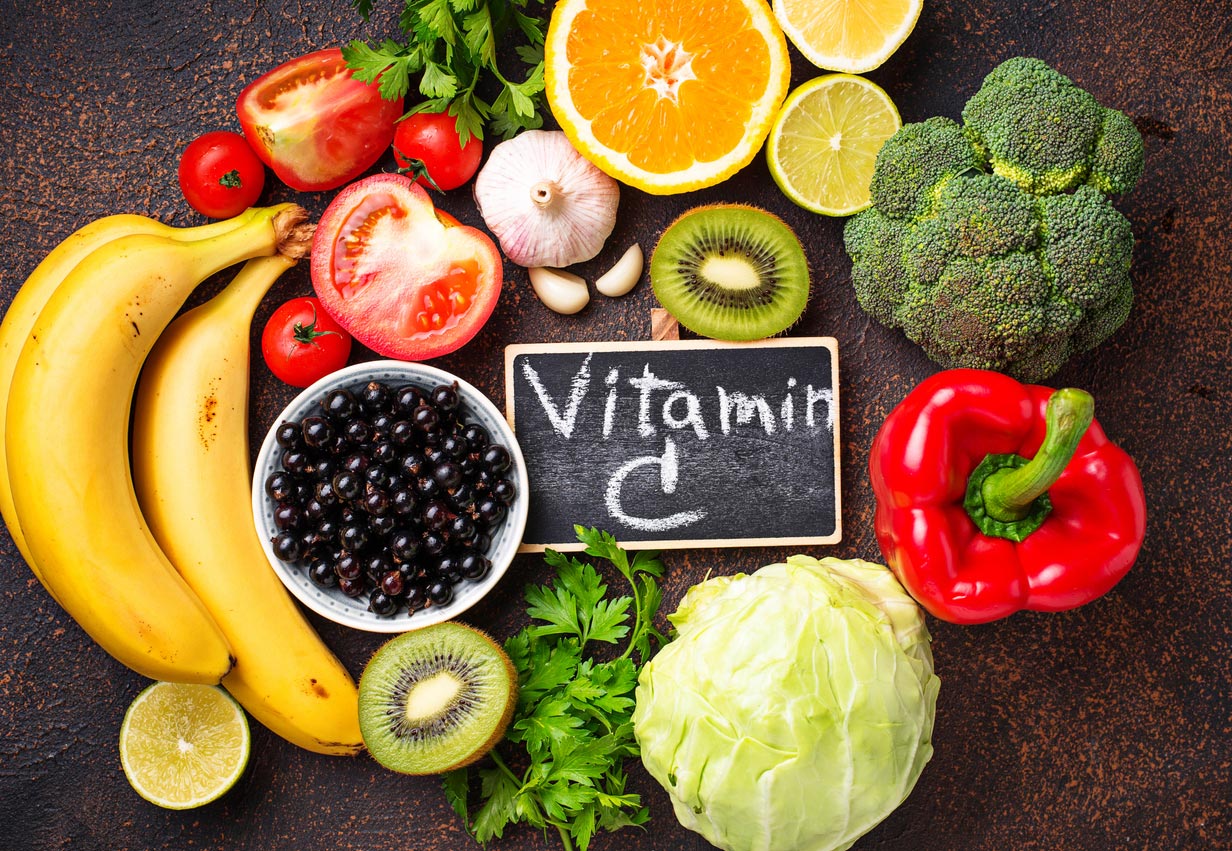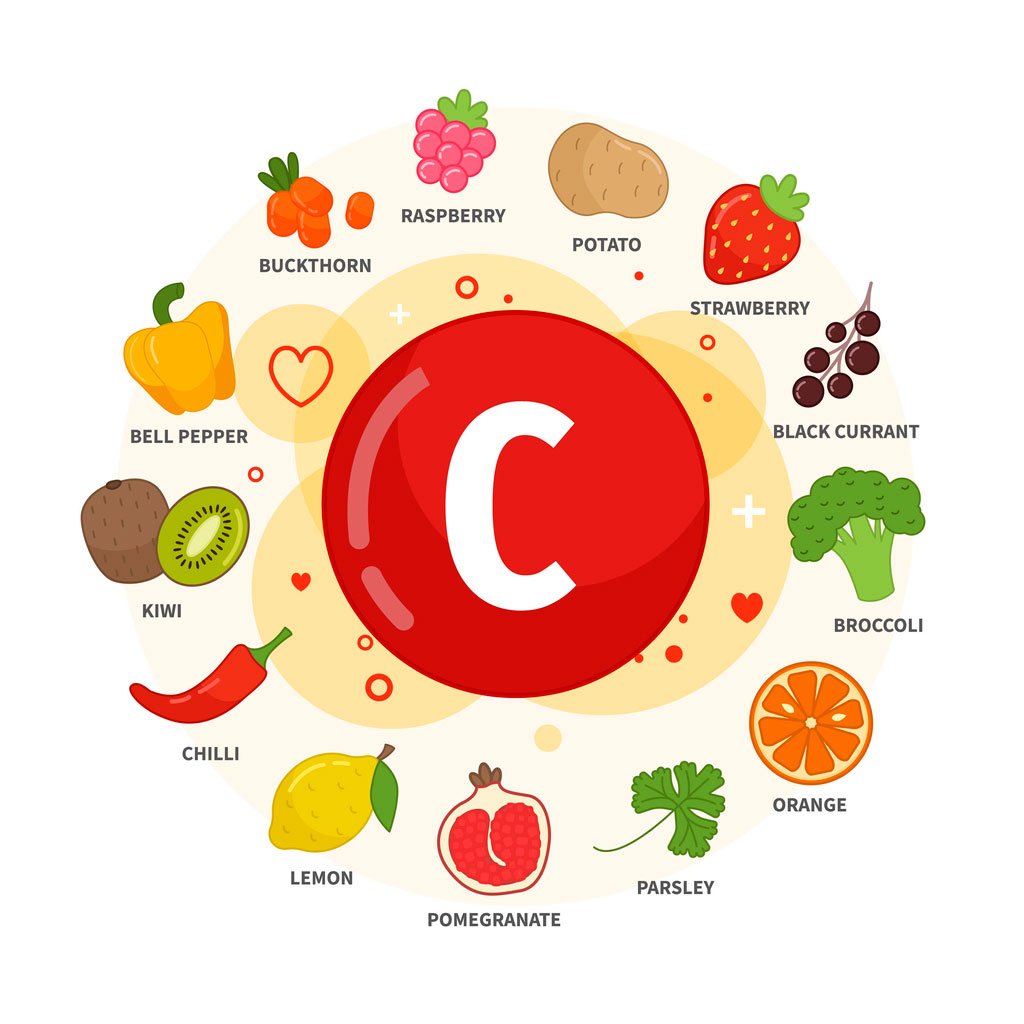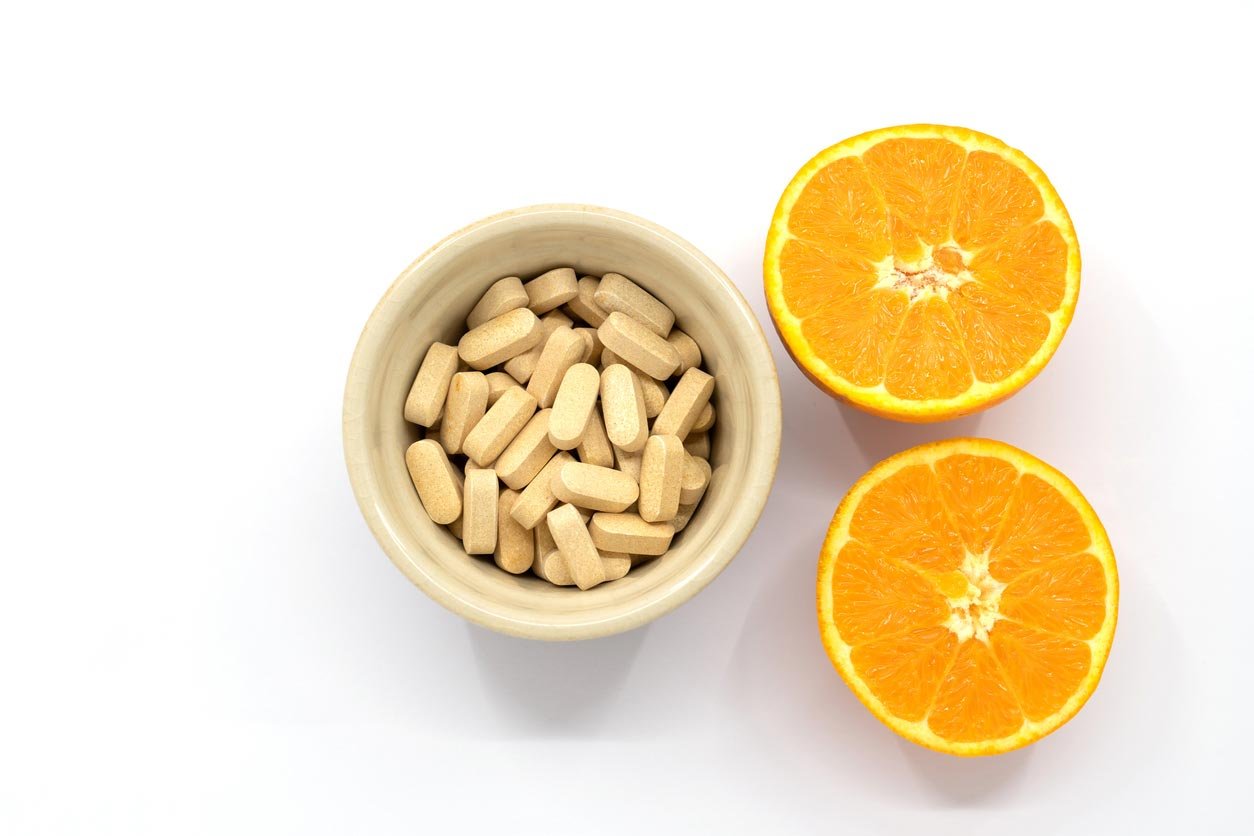
As a potent antioxidant, vitamin C reduces oxidative stress in your body. Extensive research
shows that diets rich in daily vitamin C are associated with a lower risk of many chronic diseases, such as heart disease, certain cancers, eye diseases, and neurodegenerative conditions that affect cognitive health. Vitamin C can also regenerate other antioxidants, such as vitamin E, by lowering free radicals formed when vitamin E scavenges oxygen radicals.White Blood Cells
Vitamin C may also help to promote the production and protection of white blood cells, which help your body fight off infections. This might be especially relevant to COVID-19 because many infected patients have a low white blood cell count when they contract the SARS-CoV-2 virus.
Skin Health
Vitamin C is part of your external defense system as well, as it plays a primary role in the health and integrity of your skin. This is because daily vitamin C is needed to produce collagen, the most abundant protein in your body’s connective tissue. It helps strengthen your skin’s barriers, which is important to fight the spread of COVID-19 and other viruses as well as protect your skin with all of the hand-washing you’re doing. (You are washing your hands a lot, right?)
Iron Absorption
Vitamin C boosts iron absorption, which can help prevent iron deficiency. For instance, eating a combination of tomatoes and lentils, or tomatoes and beans, at the same time, can enhance how much iron you absorb. A study published in the American Journal of Clinical Nutrition found that adding 100 mg of vitamin C (as ascorbic acid) to meals boosted iron absorption by 67%.
Chronic Disease Prevention
Studies have found vitamin C to play a role in preventing heart disease, primarily by managing blood pressure. It’s also protective against oxidative stress in the brain, especially when it comes to diseases like Alzheimer’s and dementia. Your eyes can benefit from daily vitamin C too, which may even help slow age-related diseases like cataracts. It may also help improve fertility in men, primarily by improving sperm quality.
How Much Daily Vitamin C Do You Need?

The Recommended Daily Allowance (RDA) of vitamin C varies between 15 mg-120 mg per day. Pregnant and lactating women, and the elderly, should aim for the upper end of that range. The average adult requires 75-90 mg of daily vitamin C, which you can easily obtain from a healthy, plant-centered diet. For reference, one large orange contains approximately 100 mg of vitamin C. Truth in advertising from the Florida Department of Citrus!
When you consume vitamin C in moderate amounts (say, 30-180 mg per day), your body absorbs around 70-90% of it. When you start taking more than 1,000 mg per day (nearly impossible to do without supplementation), absorption rates decrease to less than 50%. Leftover vitamin C passes out of your body in urine.
What Happens When You Don’t Get Enough Vitamin C?
Not getting enough daily vitamin C has well-established negative health effects. The primary consequence of vitamin C deficiency is scurvy, a disease in which people experience fatigue, skin rash, open and unhealing sores, bleeding gums, and bruising. If untreated, it can lead to death.
The Discovery of Scurvy
The discovery of vitamin C and scurvy happened at the same time, in the 1920s, when vitamin C deficiency was a serious and fairly common condition. Sailors on long sea voyages who subsisted on fish, dried meats, and hard tack (a basic biscuit or cracker), with no access to fresh or preserved produce, frequently experienced symptoms of scurvy, a disease characterized by the breakdown of connective tissues.
Historians estimate that between the first voyage of Columbus and the rise of the steam engine in the mid-19th century, over two million sailors perished from the disease. Shipping companies and governments assumed that half of the sailors would die from scurvy on any given voyage.
After experimenting with useless and often dangerous treatments like vinegar, “elixir of vitriol” (a particularly alarming cocktail of sulfuric acid and alcohol), and various potent laxatives, seamen finally discovered a solution in the mid-1700s. When a badly damaged British naval fleet made their way to Juan Fernández Island (off the coast of what is now Chile) with just a few hundred men left alive out of the original 1200, they (seemingly) miraculously reversed their scurvy once they began eating the foods readily available on the island: oats, clover, radishes, sorrel, and other vegetable foods rich in vitamin C.
While greens were impractical to sail with, citrus fruits could be taken on board and stored and distributed to sailors to keep them healthy. Once the sailors received fresh fruits and vegetables, scurvy could be reversed and prevented. Navies and shipping companies began taking oranges, lemons, and limes on these voyages to treat and prevent the sailors’ disease. The tie is so strong that “ascorbic” in the chemical name for vitamin C actually means “anti-scurvy.”
Scurvy Risk Today
Today, scurvy is very rare, especially if your diet is rich in fruits and veggies. Most scurvy cases are associated with a vitamin C intake of less than 10 mg per day. Some people are more at risk, however, including those who smoke, infants fed evaporated or boiled milk (as this can destroy vitamin C), people who consume diets of limited variety, and individuals who have absorption problems.
Can You Get Too Much Vitamin C?
If your body just gets rid of excess vitamin C every day, is it possible to get too much of it? The Tolerable Upper Intake Level (UL) for vitamin C is 2,000 mg, meaning that this is the amount that has been established as the highest amount generally tolerated without negative effects for most people.
The most common side effects of vitamin C, associated with excessive intake, are digestive disturbances — like diarrhea, nausea, and cramping — primarily due to unabsorbed vitamin C sitting in the gastrointestinal tract.
For a smaller number of people, excessive vitamin C can lead to more significant problems. For instance, those with hereditary hemochromatosis could be at risk for iron overload resulting in tissue damage due to the absorptive-boosting effects of vitamin C on iron. People with renal disorders may also have a heightened risk for side effects if their vitamin C intake is in excess of 1,000-2,000 mg per day. Kidney stones can form as a result of high amounts of vitamin C from supplementation, causing an increased excretion of oxalate in your urine. Though this is rare among healthy people with moderate vitamin C intakes.
Vitamin C may also have the potential to interfere with certain medications, like cholesterol-lowering statins, Adderall for ADHD, and warfarin, which is used to prevent blood clots.
For most people, however, a moderate amount of vitamin C (2,000 mg or less per day) seems to be fairly well tolerated.
Vitamin C-Rich Foods

Fruits and vegetables are very good sources of daily vitamin C. However, modern agricultural practices have depleted soil quality around the world, meaning that the soils in which crops are grown have far fewer nutrients than they used to.
An analysis of nutrient data from the Kushi Institute, conducted between 1975 and 1997, found that the average amount of vitamin C in crops had decreased by 30%. We can assume that even more depletion has occurred in the nearly 25 years since the completion of that study.
Optimizing Your Dietary Vitamin C
How do you optimize your vitamin C intake from foods? Start with choosing good sources of vitamin C (see list below). Then, pay attention to how you prepare those foods. Certain preparation methods can lower the amount of vitamin C in a food. Boiling can substantially reduce the content, whereas microwaving, surprisingly enough, preserved the most. In general, the longer and the hotter the cooking method, the more vitamin C was destroyed.
Storage methods also play a role. Fresh and frozen produce tends to have more vitamin C than canned. The longer you keep that fresh produce in your fridge or on your counter, the less vitamin C you end up with. Frozen produce is a good option as the freezing process can destroy some of the enzymes that eventually degrade vitamin C.
Though not well documented, the amount of vitamin C in fruits and veggies may also differ significantly depending on where they’re grown, how they’re grown, how long they sit after harvest, what season it is, and how they’re stored. Even fruits grown on different branches of the same tree can vary in their nutrient content!
The best way to meet vitamin C needs is to incorporate a variety of fruits and vegetables into your diet on a regular basis. Good sources of vitamin C along with their approximate vitamin C content, are listed below. Note that some of these are also found on the Environmental Working Group’s Dirty Dozen list, meaning that they are often high in pesticides when grown conventionally. So it’s a good idea to buy organic produce whenever possible.
- 1 medium guava = 126 mg
- 1 medium red bell pepper = 152 mg
- 1 medium orange = 70 mg
- 1 cup of raw broccoli = 40 mg
- 1 small lemon = 30 mg
- 1 small papaya = 95 mg
- 1 cup of raw Brussels sprouts = 75 mg
- 1 cup of raw strawberries = 60 mg
- 1 kiwi fruit = 64 mg
- ¾ cup of diced pineapple = 48 mg
- 1 cup of frozen cauliflower florets = 21 mg
- 1 cup of raw cantaloupe = 57 mg
- 1 large tomato = 25 mg
Should You Take Vitamin C Supplements?

If you’re looking to boost your daily vitamin C intake well beyond the RDA, you can either eat a very large amount of vitamin C-rich foods like oranges, guavas, and red bell peppers, or you may want to consider supplementation. And while getting nutrients from food is almost always best, there are some compelling studies to back up the notion that for some people, vitamin C supplementation could be helpful. Perhaps especially in the time of the COVID-19 pandemic.
Vitamin C supplementation has been found to reduce severity and shorten recovery time from illnesses, including viral infections like cold and flu. It can support your body’s natural defenses and fight inflammation. And there is some evidence from animal research and case studies in humans that high dose, or IV vitamin C, can reduce lung inflammation in severe respiratory illnesses caused by H1N1 (“swine flu”) or other similar viruses.
Vitamin C for COVID-19
What about COVID-19? Some scientists believe that vitamin C supplementation could be helpful in calming the cytokine storms that often accompany this illness. Cytokines are proteins released by cells that ramp up your immune response. In some people, an overactive immune system gets stuck in a loop and releases so many cytokines that the lungs become inflamed. Severe lung inflammation with COVID-19 can result in respiratory distress and even death. Until we have studies that test the use of supplemental vitamin C in the treatment of COVID-19, specifically, we won’t know if it helps to reduce cytokine storms or not. But it seems plausible that it could.
Research is currently underway in China, as multiple studies seek to find out if high doses of IV vitamin C can shorten COVID-19 recovery time. So far, researchers have noted that it may reduce ICU length and shorten time on ventilators. Based on initial research, the Shanghai Medical Association endorsed the use of high dose vitamin C as a treatment for hospitalized people with COVID-19. However, more study is necessary to know with confidence, whether and how much vitamin C is helpful.
Best Vitamin C Supplement
One way to get very high doses of vitamin C is through intravenous, or IV, therapy. However, this can be very costly and isn’t nearly as convenient or accessible as oral vitamin C.
On the other hand, conventional oral vitamin C supplements, often in the form of vitamin C capsules, lozenges, or gummies, can have some drawbacks. For instance, they might contain highly processed ingredients, artificial fillers, and “natural” flavorings. Some also contain added sugars.
Additionally, digestive issues can accompany large amounts of vitamin C via supplements. Ascorbic acid — the supplemental form of vitamin C — has a very low pH, meaning that it’s highly acidic. When a supplement doesn’t adequately buffer the ascorbic acid, it can lead to cramping, diarrhea, and other stomach-related issues in some people.
Liposomal Vitamin C
Liposomal vitamin C is another option to consider. This form is encapsulated in liposomes or double-layered, protective fat bubbles that deliver nutrients to cells in your body. Research shows that liposomal vitamin C is more effective and bioavailable than conventional oral vitamin C supplements.
Liposomes protect the vitamin C micelles from environmental threats and absorption barriers found in the human digestive system. As they go through your intestinal tract, the liposomes gently peel away, gradually releasing the vitamin C micelles and depositing them near the gut lining where they’re better absorbed.
Support Your Immune System with Vitamin C

Vitamin C is a known antioxidant, is found in some of the healthiest foods on the planet, and seems to be good for immune health too. Eating vitamin C-rich fruits and vegetables in normal quantities has no apparent downside. And taking vitamin C supplements may have some positive benefits, though there is more to learn.
Whether or not supplemental vitamin C is beneficial in the prevention or treatment of COVID-19 is an open question. But there’s little doubt that eating a diet that’s abundant in vitamin C-rich foods is good for your health — pandemic or no pandemic.





Комментариев нет:
Отправить комментарий